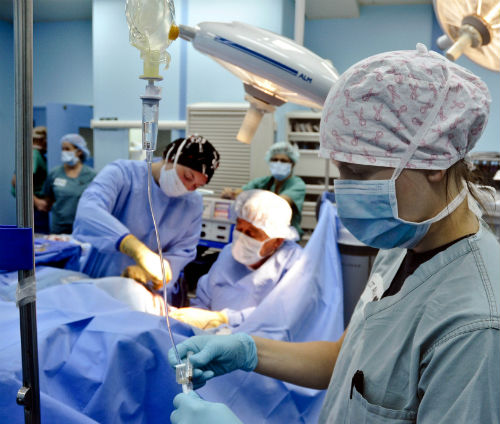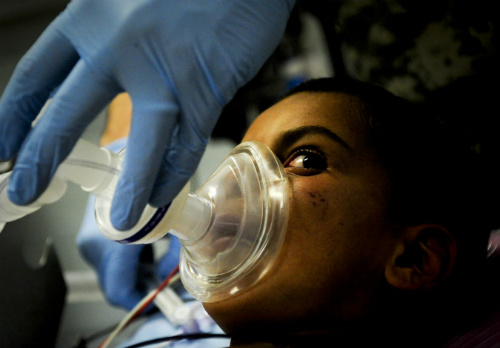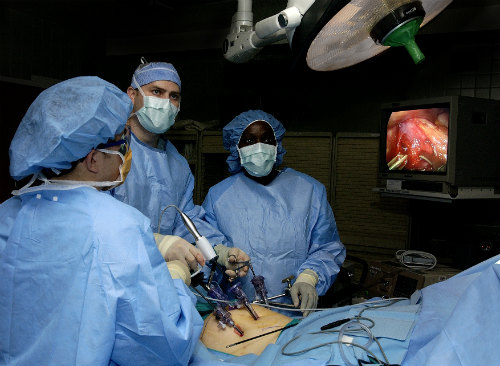- Nociception index may provide objective measure of subjective pain experience.
- In testing, the index mirrored physiologic responses normally observed by anesthesiologists during surgery.
- If effective device may improve titration of analgesic and anesthetic drugs during surgery.
- Device would be first method to objectively measure subjective pain experience.
A new clinical device appears to be able to measure surgical patient’s subjective experience of pain and to report succinctly to the anesthesiologist managing the case. The anesthesiologist can use the information to titrate anesthetic and analgesic dosages intraoperatively (Figure 1). Results of a trial of the nociception level (NoL) index were reported recently in Anesthesiology.
The device, called the Nociception Level (NoL) Index has been developed and tested by clinical researchers in cooperation with the manufacturer, Medasense Biometrics in Ramat-Gan, Israel. The NoL evaluates a number of clinical variables including heart rate, heart rate variability, photoplethysmograph wave amplitude, skin conductance, skin conductance fluctuations, and the time derivatives of these measures. By synthesizing these variables, the device, the PMD-200, is said to be able to provide an objective measure of patients’ subjective experience of pain during anesthesia (Figure 2).

aboard the Military Sealift Command hospital ship USNS Mercy.
(Sources: Flickr/Official Navy Page from United States of America
Kristopher Radder/U.S. Navy/Public Domain.)
A Significant Development?
“There’s currently no standardized, objective method for physicians to monitor the effectiveness of pain relieving drugs being administered during surgery,” said Ruth Edry, MD, lead study author and Senior Physician Anesthesiologist at the Rambam Medical Center in Haifa, Israel.
“Not effectively monitoring bodily responses to painful stimulation can lead to insufficient amounts of pain medication being administered, which can result in the patient having severe pain upon regaining consciousness from anesthesia, while too much medication may cause other side effects such as nausea and vomiting or respiratory complications,” said Dr. Edry in a press release published by the American Society of Anesthesiologists (ASA).
By synthesizing these variables, the device, the PMD-200,
is said to be able to provide an objective measure
of patients’ subjective experience of pain.
“This is the most important new anesthesia device,” Daniel I. Sessler, MD, told MDalert.com. “Typically, anesthesiologists use opioids to moderate nociception during anesthesia. The difficulty is that too little promotes postoperative pain, whereas excessive doses can cause complications including nausea and vomiting, respiratory complications, constipation, and hyperalgesia.
“Our study shows that NoL, a measure of intraoperative nociception, is an intensity-sensitive measure that is blocked by opioid administration. Titrating to NoL may thus guide clinicians and help them give patient-specific optimal amounts of intraoperative opioid,” Dr. Sessler explained.

(Sources: Wikipedia/ISAF Headquarters Public Affairs Office.
Originally posted to Flickr as 100410-F-7713A-002/Public Domain.)
Both Dr. Sessler and Dr. Edry have personal financial interests in the successful marketing of this new device.
The Study
The study included 58 patients undergoing a variety of surgical procedures, including laparoscopic (Figure 3) and open abdominal surgeries with intubation. The researchers found that “the NoL index responded progressively to increased stimulus intensity and remained unchanged in response to nonnoxious stimuli.”
Intraoperative NoL was compared to heart rate, pulse plethysmograph amplitude, noninvasive blood pressure, and the surgical photoplethysmograph index around 5 specific stimuli: tetanic stimulation with and without fentanyl analgesia, intubation, first incision/trocar insertion, and a nonnoxious period. The response around first incision was analyzed at 2 target plasma concentrations of remifentanil.
Compared to other accepted measures of nociception, the NoL index better discriminated noxious from nonnoxious stimuli with an area under the curve (AOC) of 0.93 (95% confidence interval [CI], 0.89 to 0.97). The NoL/PMD-100 had a sensitivity of 87% at a specificity of 84%. “The NoL index was the only measure that reliably reflected two different analgesic concentrations of remifentanil during initial skin incision or trocar insertion,” the authors noted in the Anesthesiology abstract.
The researchers found that the NoL index changed proportionately with patients' response to various clinical and experimental noxious stimuli. Further, the NoL/PMD-100 discriminated noxious from nonnoxious stimuli with high sensitivity and specificity. The NoL index also responded progressively to increasing stimuli intensity and was found to be appropriately blunted by analgesic administration. The NoL index was superior to other compared measures and appears to accurately characterize nociception during general anesthesia.

(Sources: Wikipedia/By Samuel Bendet, US Air Force - VIRIN: 050131-F-1936B-008/Public Domain.)
Skepticism
Paul White, MD, PhD, was not nearly as impressed by the findings. “This appears to be a well-conducted clinical study with predictable results. Previous studies have reported that these each of these variables have some predictive value so the combination would be expected to be stronger than any one alone,” he told MDalert.com.
“The real question is where the use of this device has any significant influence on measurable clinical outcomes (e.g., recovery times, side effects, adverse events [intraoperative recall], pharmacoeconomics, OR efficiency, patient safety, etc). Otherwise it is just another expensive toy.”
The accepted measures to which Dr. White was referring included heart rate, pulse plethysmograph amplitude, noninvasive blood pressure, and the surgical photoplethysmograph index around five specific stimuli: tetanic stimulation with and without fentanyl analgesia, intubation, first incision/trocar insertion, and a nonnoxious period. The response around first incision was analyzed at two target plasma concentrations of remifentanil.
Dr. White is Consultant at Cedars-Sinai Medical Center at Los Angeles and the Rizzoli Institute at the University of Bologna, Italy. He a retired professor and former holder of the Margaret Milam McDermott Distinguished Chair of Anesthesiology at The University of Texas Southwestern Medical Center at Dallas.
Conclusions
According to the ASA press release, “Compared to other accepted monitors for measuring the body’s response to painful stimulation during surgery, the nociception (pain) index better discriminated presumed pain-causing stimuli from non-pain-causing stimuli. The index also accurately quantified the body’s response to increasingly more painful stimulation, with high sensitivity and specificity, as well as showed a decrease when pain medication was administered.”
